Agile Methodology: Improving Project Management with Flexibility
VerifiedAdded on 2023/06/04
|15
|3763
|256
Report
AI Summary
This report provides a comprehensive overview of Agile Methodology in project management, detailing its history, processes, advantages, and disadvantages. It begins by defining agile methodology as a flexible software development process rooted in iteration, emphasizing customer satisfaction and adaptability to changing requirements. The report traces the history of agile from its origins in iterative methods in the 1950s to its formalization in the Agile Manifesto of 2001. It outlines the core principles of agile, including iterative development, modularity, and parsimony, and describes the agile process flow from concept to retirement. A comparison is made between agile and other methodologies like Waterfall and Scrum, highlighting the differences in structure, flexibility, and focus. The report also discusses the benefits of agile, such as enhanced client satisfaction and improved team communication, as well as its drawbacks. Finally, it touches on the applications of agile in various project scenarios. Desklib provides students access to this and other solved assignments.
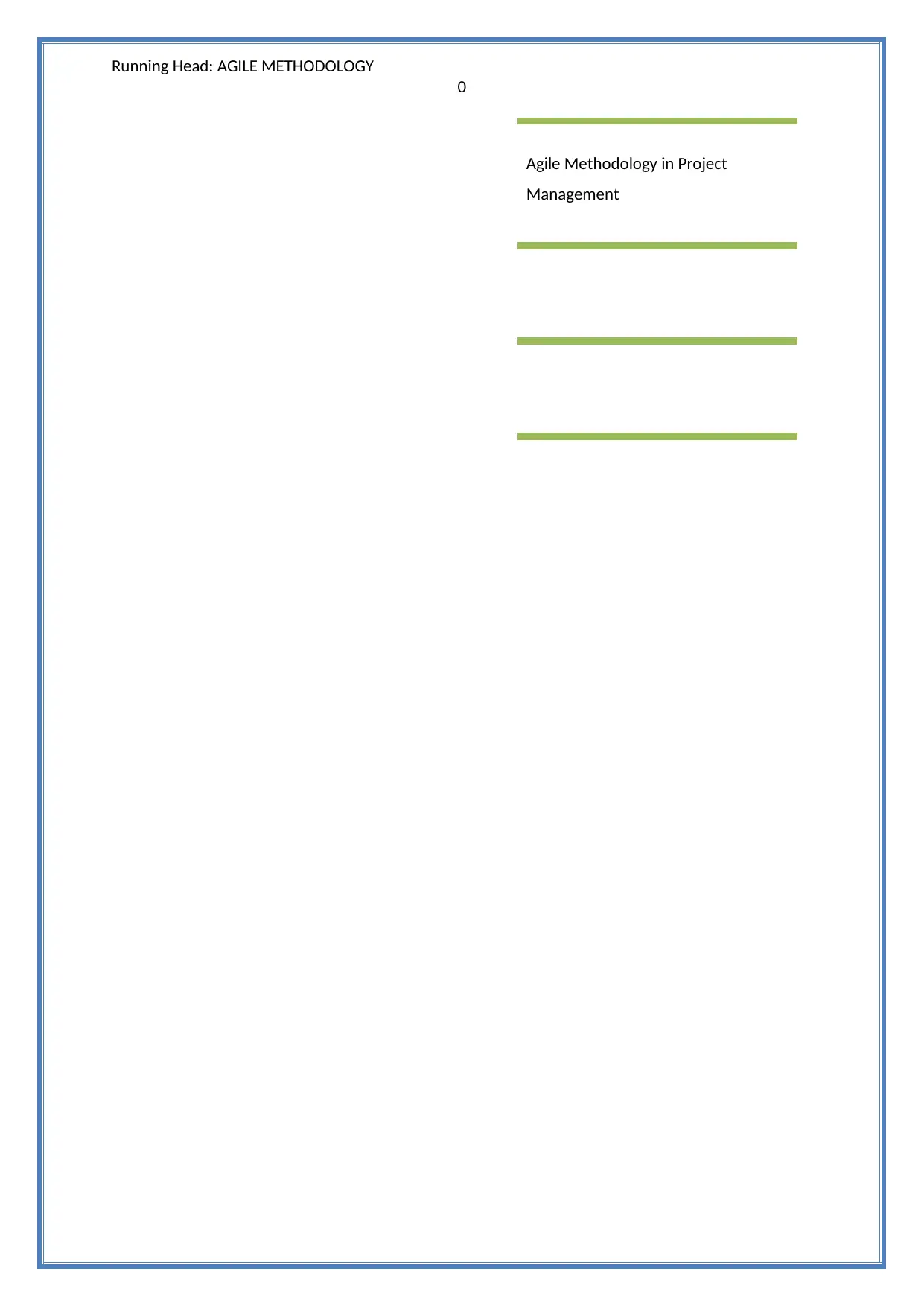
Running Head: AGILE METHODOLOGY
0
Agile Methodology in Project
Management
0
Agile Methodology in Project
Management
Paraphrase This Document
Need a fresh take? Get an instant paraphrase of this document with our AI Paraphraser
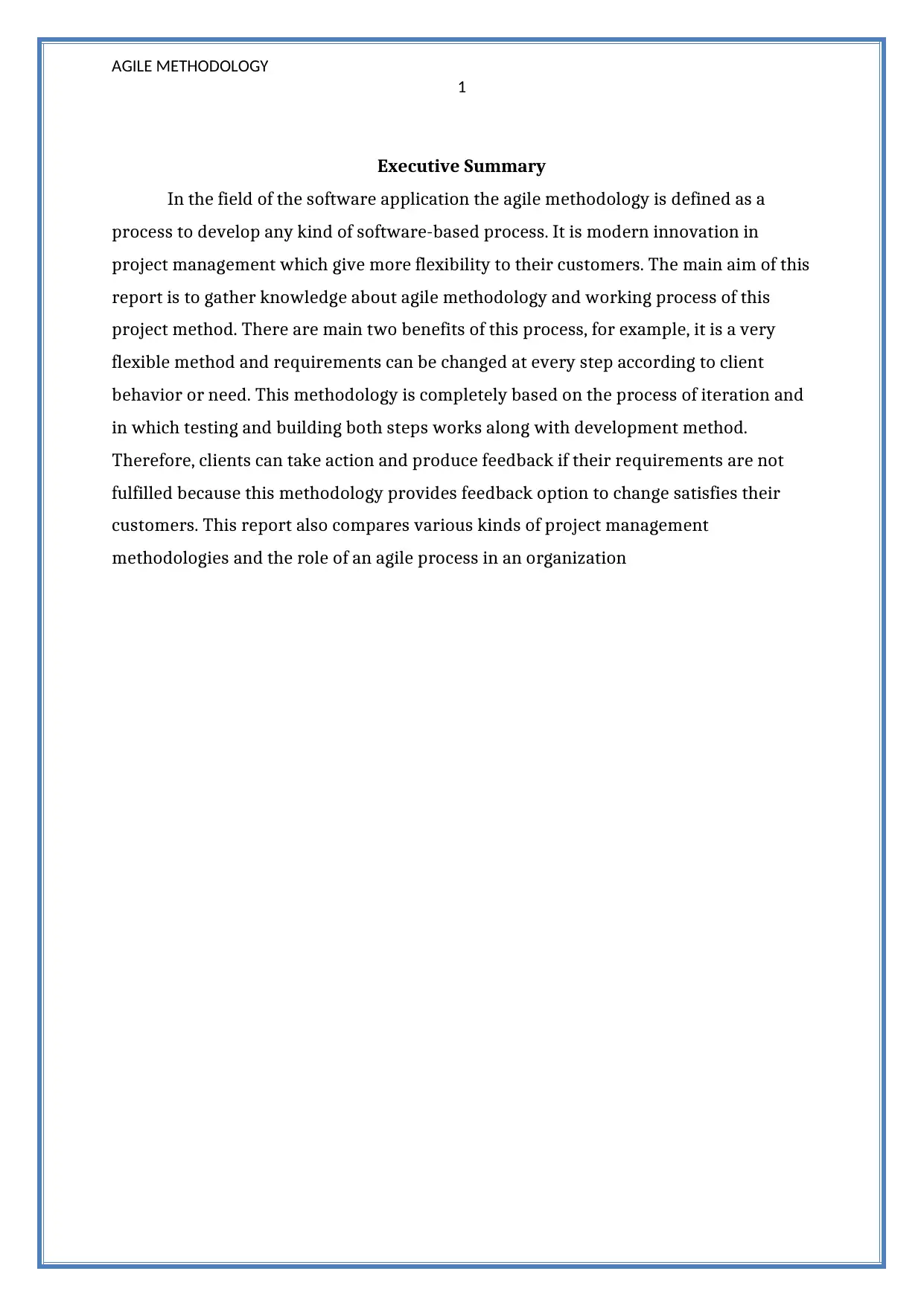
AGILE METHODOLOGY
1
Executive Summary
In the field of the software application the agile methodology is defined as a
process to develop any kind of software-based process. It is modern innovation in
project management which give more flexibility to their customers. The main aim of this
report is to gather knowledge about agile methodology and working process of this
project method. There are main two benefits of this process, for example, it is a very
flexible method and requirements can be changed at every step according to client
behavior or need. This methodology is completely based on the process of iteration and
in which testing and building both steps works along with development method.
Therefore, clients can take action and produce feedback if their requirements are not
fulfilled because this methodology provides feedback option to change satisfies their
customers. This report also compares various kinds of project management
methodologies and the role of an agile process in an organization
1
Executive Summary
In the field of the software application the agile methodology is defined as a
process to develop any kind of software-based process. It is modern innovation in
project management which give more flexibility to their customers. The main aim of this
report is to gather knowledge about agile methodology and working process of this
project method. There are main two benefits of this process, for example, it is a very
flexible method and requirements can be changed at every step according to client
behavior or need. This methodology is completely based on the process of iteration and
in which testing and building both steps works along with development method.
Therefore, clients can take action and produce feedback if their requirements are not
fulfilled because this methodology provides feedback option to change satisfies their
customers. This report also compares various kinds of project management
methodologies and the role of an agile process in an organization
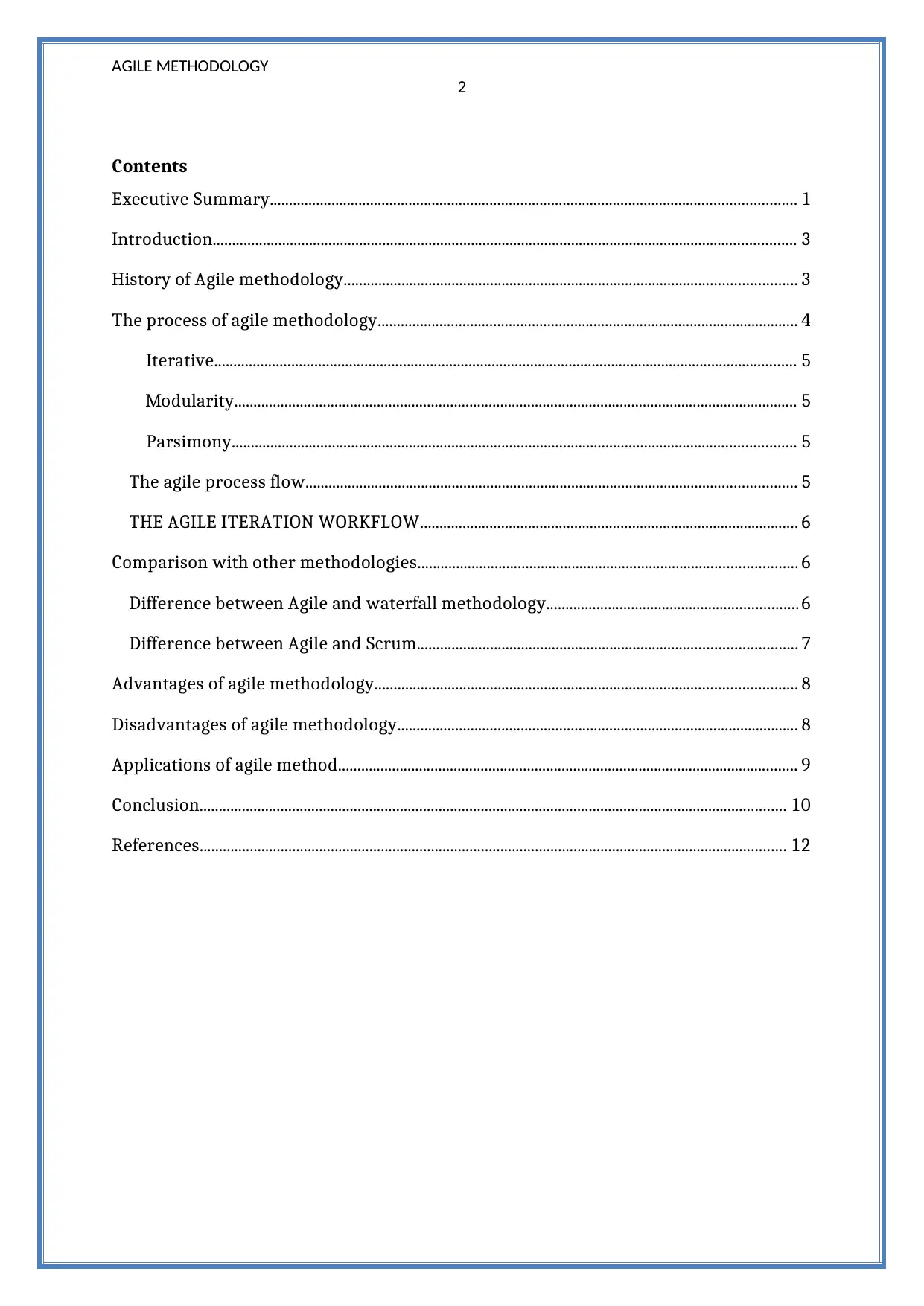
AGILE METHODOLOGY
2
Contents
Executive Summary........................................................................................................................................ 1
Introduction....................................................................................................................................................... 3
History of Agile methodology..................................................................................................................... 3
The process of agile methodology............................................................................................................. 4
Iterative....................................................................................................................................................... 5
Modularity.................................................................................................................................................. 5
Parsimony.................................................................................................................................................. 5
The agile process flow............................................................................................................................... 5
THE AGILE ITERATION WORKFLOW.................................................................................................. 6
Comparison with other methodologies.................................................................................................. 6
Difference between Agile and waterfall methodology.................................................................6
Difference between Agile and Scrum.................................................................................................. 7
Advantages of agile methodology............................................................................................................. 8
Disadvantages of agile methodology........................................................................................................ 8
Applications of agile method....................................................................................................................... 9
Conclusion........................................................................................................................................................ 10
References........................................................................................................................................................ 12
2
Contents
Executive Summary........................................................................................................................................ 1
Introduction....................................................................................................................................................... 3
History of Agile methodology..................................................................................................................... 3
The process of agile methodology............................................................................................................. 4
Iterative....................................................................................................................................................... 5
Modularity.................................................................................................................................................. 5
Parsimony.................................................................................................................................................. 5
The agile process flow............................................................................................................................... 5
THE AGILE ITERATION WORKFLOW.................................................................................................. 6
Comparison with other methodologies.................................................................................................. 6
Difference between Agile and waterfall methodology.................................................................6
Difference between Agile and Scrum.................................................................................................. 7
Advantages of agile methodology............................................................................................................. 8
Disadvantages of agile methodology........................................................................................................ 8
Applications of agile method....................................................................................................................... 9
Conclusion........................................................................................................................................................ 10
References........................................................................................................................................................ 12
⊘ This is a preview!⊘
Do you want full access?
Subscribe today to unlock all pages.

Trusted by 1+ million students worldwide
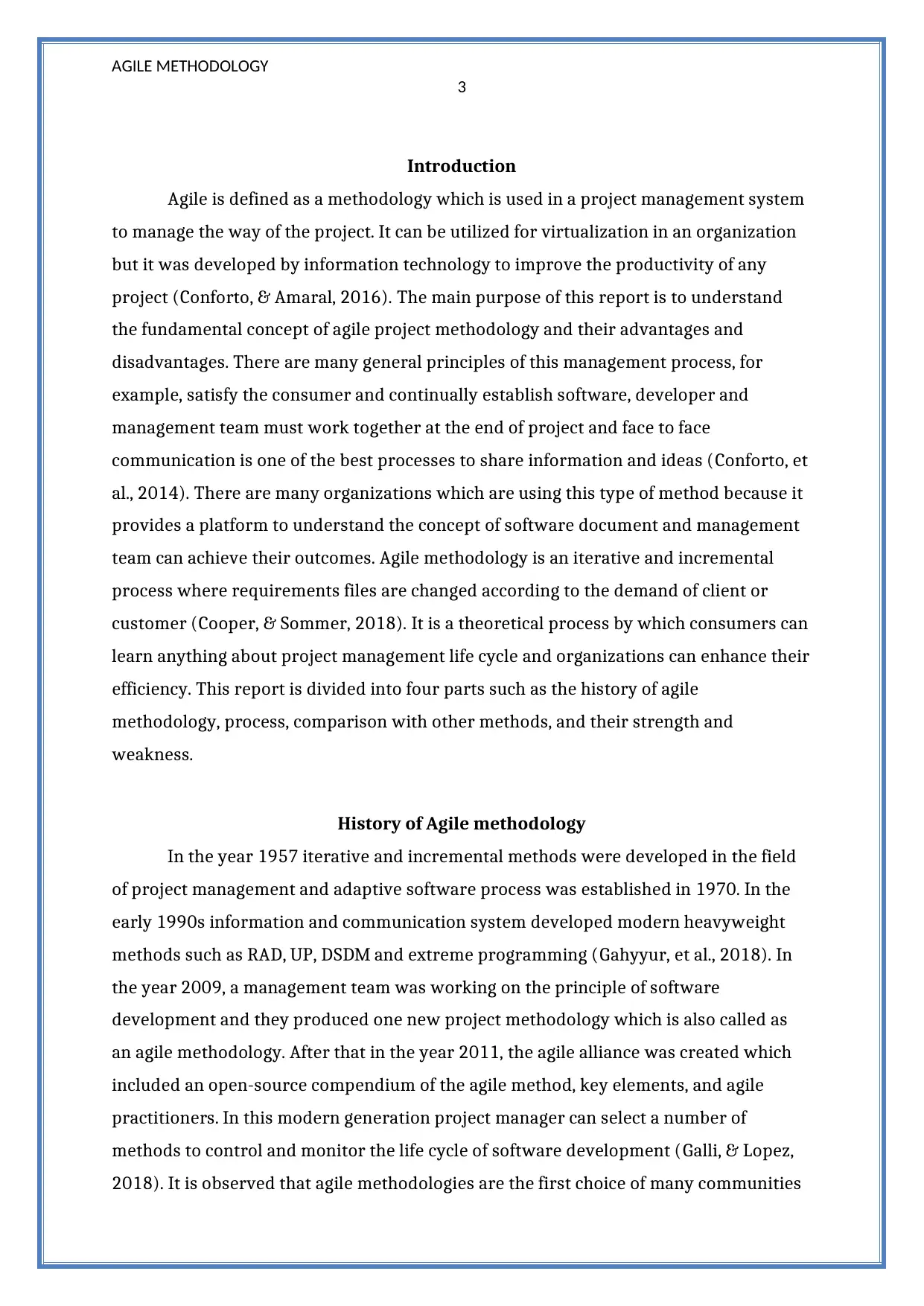
AGILE METHODOLOGY
3
Introduction
Agile is defined as a methodology which is used in a project management system
to manage the way of the project. It can be utilized for virtualization in an organization
but it was developed by information technology to improve the productivity of any
project (Conforto, & Amaral, 2016). The main purpose of this report is to understand
the fundamental concept of agile project methodology and their advantages and
disadvantages. There are many general principles of this management process, for
example, satisfy the consumer and continually establish software, developer and
management team must work together at the end of project and face to face
communication is one of the best processes to share information and ideas (Conforto, et
al., 2014). There are many organizations which are using this type of method because it
provides a platform to understand the concept of software document and management
team can achieve their outcomes. Agile methodology is an iterative and incremental
process where requirements files are changed according to the demand of client or
customer (Cooper, & Sommer, 2018). It is a theoretical process by which consumers can
learn anything about project management life cycle and organizations can enhance their
efficiency. This report is divided into four parts such as the history of agile
methodology, process, comparison with other methods, and their strength and
weakness.
History of Agile methodology
In the year 1957 iterative and incremental methods were developed in the field
of project management and adaptive software process was established in 1970. In the
early 1990s information and communication system developed modern heavyweight
methods such as RAD, UP, DSDM and extreme programming (Gahyyur, et al., 2018). In
the year 2009, a management team was working on the principle of software
development and they produced one new project methodology which is also called as
an agile methodology. After that in the year 2011, the agile alliance was created which
included an open-source compendium of the agile method, key elements, and agile
practitioners. In this modern generation project manager can select a number of
methods to control and monitor the life cycle of software development (Galli, & Lopez,
2018). It is observed that agile methodologies are the first choice of many communities
3
Introduction
Agile is defined as a methodology which is used in a project management system
to manage the way of the project. It can be utilized for virtualization in an organization
but it was developed by information technology to improve the productivity of any
project (Conforto, & Amaral, 2016). The main purpose of this report is to understand
the fundamental concept of agile project methodology and their advantages and
disadvantages. There are many general principles of this management process, for
example, satisfy the consumer and continually establish software, developer and
management team must work together at the end of project and face to face
communication is one of the best processes to share information and ideas (Conforto, et
al., 2014). There are many organizations which are using this type of method because it
provides a platform to understand the concept of software document and management
team can achieve their outcomes. Agile methodology is an iterative and incremental
process where requirements files are changed according to the demand of client or
customer (Cooper, & Sommer, 2018). It is a theoretical process by which consumers can
learn anything about project management life cycle and organizations can enhance their
efficiency. This report is divided into four parts such as the history of agile
methodology, process, comparison with other methods, and their strength and
weakness.
History of Agile methodology
In the year 1957 iterative and incremental methods were developed in the field
of project management and adaptive software process was established in 1970. In the
early 1990s information and communication system developed modern heavyweight
methods such as RAD, UP, DSDM and extreme programming (Gahyyur, et al., 2018). In
the year 2009, a management team was working on the principle of software
development and they produced one new project methodology which is also called as
an agile methodology. After that in the year 2011, the agile alliance was created which
included an open-source compendium of the agile method, key elements, and agile
practitioners. In this modern generation project manager can select a number of
methods to control and monitor the life cycle of software development (Galli, & Lopez,
2018). It is observed that agile methodologies are the first choice of many communities
Paraphrase This Document
Need a fresh take? Get an instant paraphrase of this document with our AI Paraphraser
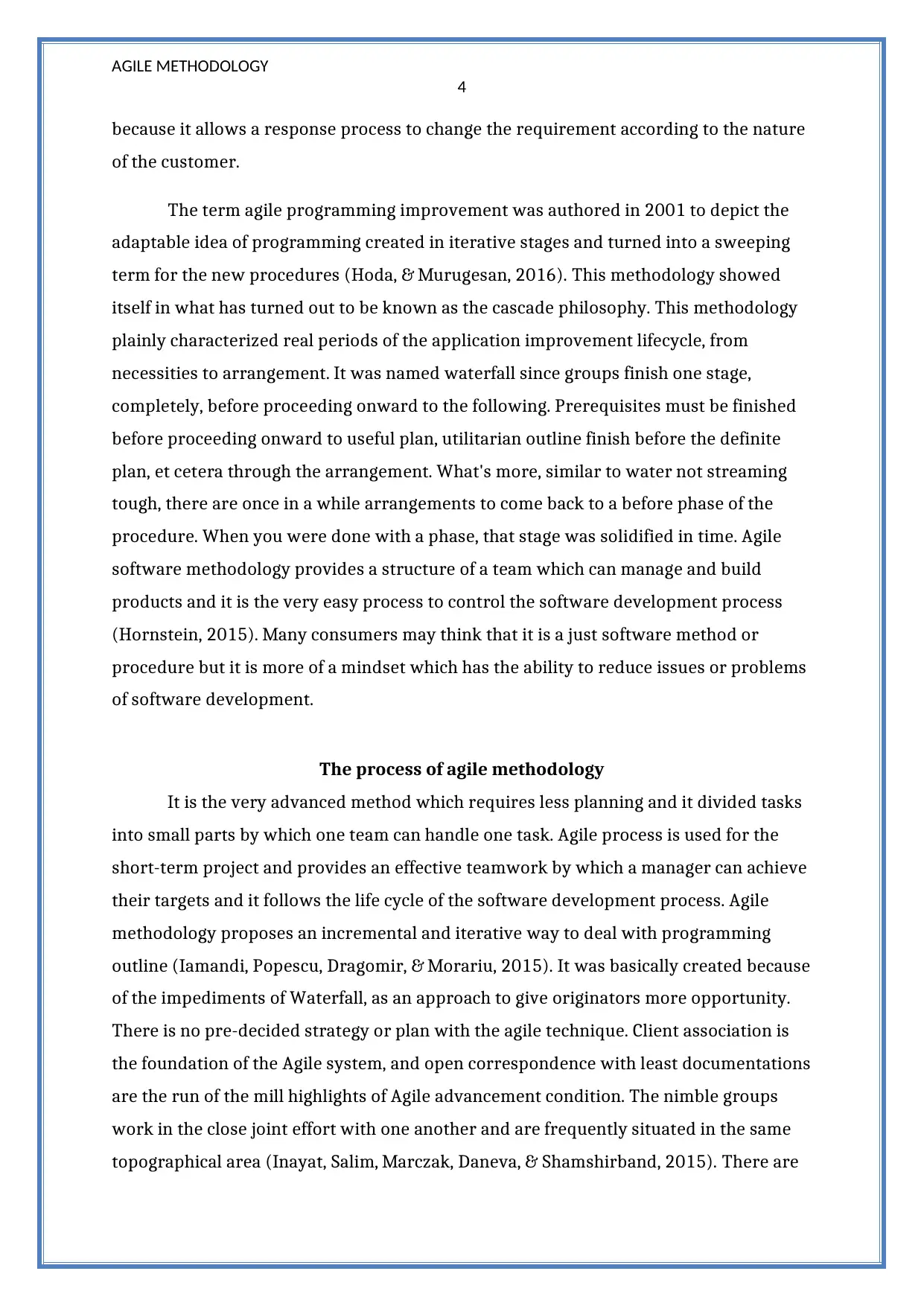
AGILE METHODOLOGY
4
because it allows a response process to change the requirement according to the nature
of the customer.
The term agile programming improvement was authored in 2001 to depict the
adaptable idea of programming created in iterative stages and turned into a sweeping
term for the new procedures (Hoda, & Murugesan, 2016). This methodology showed
itself in what has turned out to be known as the cascade philosophy. This methodology
plainly characterized real periods of the application improvement lifecycle, from
necessities to arrangement. It was named waterfall since groups finish one stage,
completely, before proceeding onward to the following. Prerequisites must be finished
before proceeding onward to useful plan, utilitarian outline finish before the definite
plan, et cetera through the arrangement. What's more, similar to water not streaming
tough, there are once in a while arrangements to come back to a before phase of the
procedure. When you were done with a phase, that stage was solidified in time. Agile
software methodology provides a structure of a team which can manage and build
products and it is the very easy process to control the software development process
(Hornstein, 2015). Many consumers may think that it is a just software method or
procedure but it is more of a mindset which has the ability to reduce issues or problems
of software development.
The process of agile methodology
It is the very advanced method which requires less planning and it divided tasks
into small parts by which one team can handle one task. Agile process is used for the
short-term project and provides an effective teamwork by which a manager can achieve
their targets and it follows the life cycle of the software development process. Agile
methodology proposes an incremental and iterative way to deal with programming
outline (Iamandi, Popescu, Dragomir, & Morariu, 2015). It was basically created because
of the impediments of Waterfall, as an approach to give originators more opportunity.
There is no pre-decided strategy or plan with the agile technique. Client association is
the foundation of the Agile system, and open correspondence with least documentations
are the run of the mill highlights of Agile advancement condition. The nimble groups
work in the close joint effort with one another and are frequently situated in the same
topographical area (Inayat, Salim, Marczak, Daneva, & Shamshirband, 2015). There are
4
because it allows a response process to change the requirement according to the nature
of the customer.
The term agile programming improvement was authored in 2001 to depict the
adaptable idea of programming created in iterative stages and turned into a sweeping
term for the new procedures (Hoda, & Murugesan, 2016). This methodology showed
itself in what has turned out to be known as the cascade philosophy. This methodology
plainly characterized real periods of the application improvement lifecycle, from
necessities to arrangement. It was named waterfall since groups finish one stage,
completely, before proceeding onward to the following. Prerequisites must be finished
before proceeding onward to useful plan, utilitarian outline finish before the definite
plan, et cetera through the arrangement. What's more, similar to water not streaming
tough, there are once in a while arrangements to come back to a before phase of the
procedure. When you were done with a phase, that stage was solidified in time. Agile
software methodology provides a structure of a team which can manage and build
products and it is the very easy process to control the software development process
(Hornstein, 2015). Many consumers may think that it is a just software method or
procedure but it is more of a mindset which has the ability to reduce issues or problems
of software development.
The process of agile methodology
It is the very advanced method which requires less planning and it divided tasks
into small parts by which one team can handle one task. Agile process is used for the
short-term project and provides an effective teamwork by which a manager can achieve
their targets and it follows the life cycle of the software development process. Agile
methodology proposes an incremental and iterative way to deal with programming
outline (Iamandi, Popescu, Dragomir, & Morariu, 2015). It was basically created because
of the impediments of Waterfall, as an approach to give originators more opportunity.
There is no pre-decided strategy or plan with the agile technique. Client association is
the foundation of the Agile system, and open correspondence with least documentations
are the run of the mill highlights of Agile advancement condition. The nimble groups
work in the close joint effort with one another and are frequently situated in the same
topographical area (Inayat, Salim, Marczak, Daneva, & Shamshirband, 2015). There are
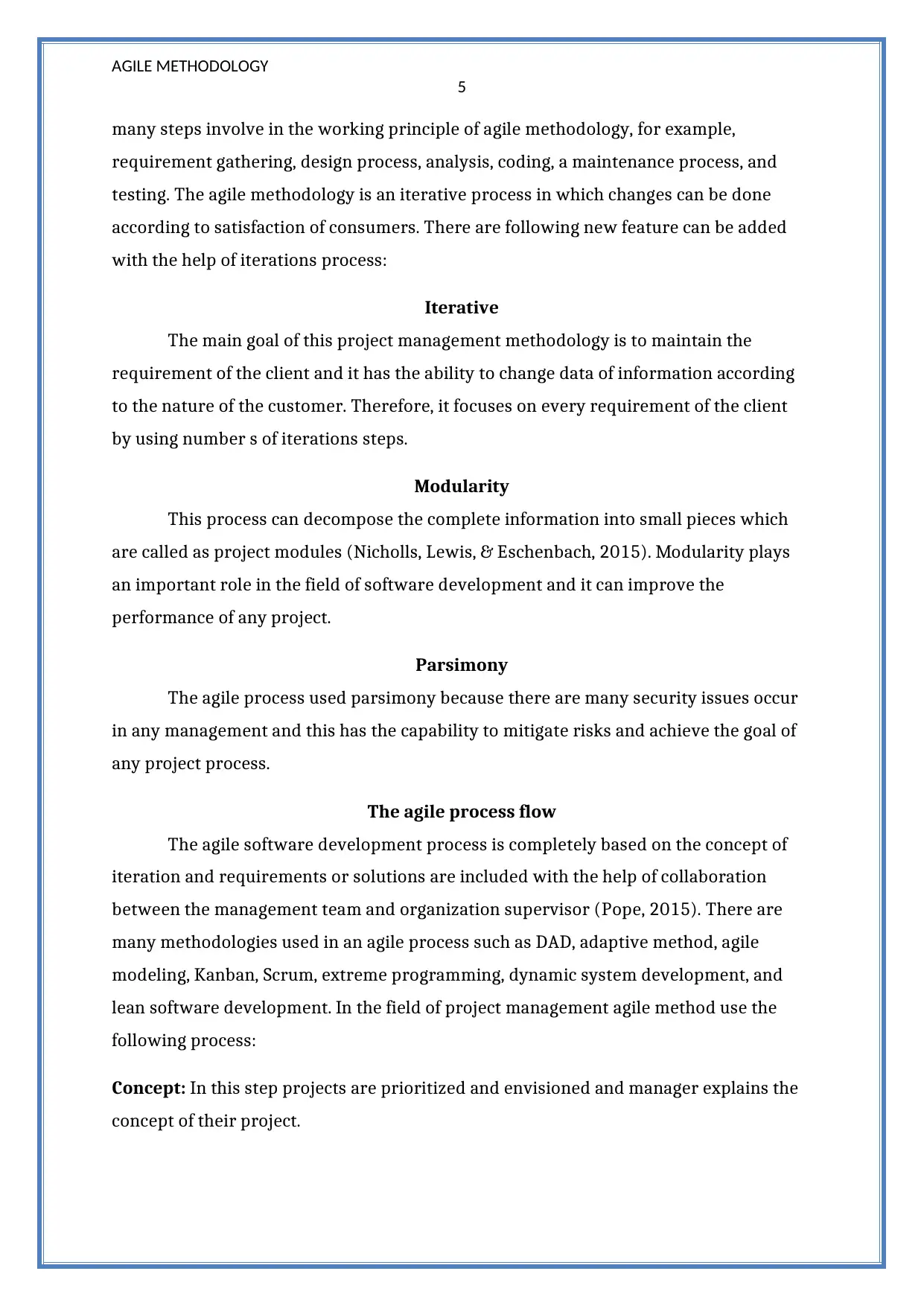
AGILE METHODOLOGY
5
many steps involve in the working principle of agile methodology, for example,
requirement gathering, design process, analysis, coding, a maintenance process, and
testing. The agile methodology is an iterative process in which changes can be done
according to satisfaction of consumers. There are following new feature can be added
with the help of iterations process:
Iterative
The main goal of this project management methodology is to maintain the
requirement of the client and it has the ability to change data of information according
to the nature of the customer. Therefore, it focuses on every requirement of the client
by using number s of iterations steps.
Modularity
This process can decompose the complete information into small pieces which
are called as project modules (Nicholls, Lewis, & Eschenbach, 2015). Modularity plays
an important role in the field of software development and it can improve the
performance of any project.
Parsimony
The agile process used parsimony because there are many security issues occur
in any management and this has the capability to mitigate risks and achieve the goal of
any project process.
The agile process flow
The agile software development process is completely based on the concept of
iteration and requirements or solutions are included with the help of collaboration
between the management team and organization supervisor (Pope, 2015). There are
many methodologies used in an agile process such as DAD, adaptive method, agile
modeling, Kanban, Scrum, extreme programming, dynamic system development, and
lean software development. In the field of project management agile method use the
following process:
Concept: In this step projects are prioritized and envisioned and manager explains the
concept of their project.
5
many steps involve in the working principle of agile methodology, for example,
requirement gathering, design process, analysis, coding, a maintenance process, and
testing. The agile methodology is an iterative process in which changes can be done
according to satisfaction of consumers. There are following new feature can be added
with the help of iterations process:
Iterative
The main goal of this project management methodology is to maintain the
requirement of the client and it has the ability to change data of information according
to the nature of the customer. Therefore, it focuses on every requirement of the client
by using number s of iterations steps.
Modularity
This process can decompose the complete information into small pieces which
are called as project modules (Nicholls, Lewis, & Eschenbach, 2015). Modularity plays
an important role in the field of software development and it can improve the
performance of any project.
Parsimony
The agile process used parsimony because there are many security issues occur
in any management and this has the capability to mitigate risks and achieve the goal of
any project process.
The agile process flow
The agile software development process is completely based on the concept of
iteration and requirements or solutions are included with the help of collaboration
between the management team and organization supervisor (Pope, 2015). There are
many methodologies used in an agile process such as DAD, adaptive method, agile
modeling, Kanban, Scrum, extreme programming, dynamic system development, and
lean software development. In the field of project management agile method use the
following process:
Concept: In this step projects are prioritized and envisioned and manager explains the
concept of their project.
⊘ This is a preview!⊘
Do you want full access?
Subscribe today to unlock all pages.

Trusted by 1+ million students worldwide
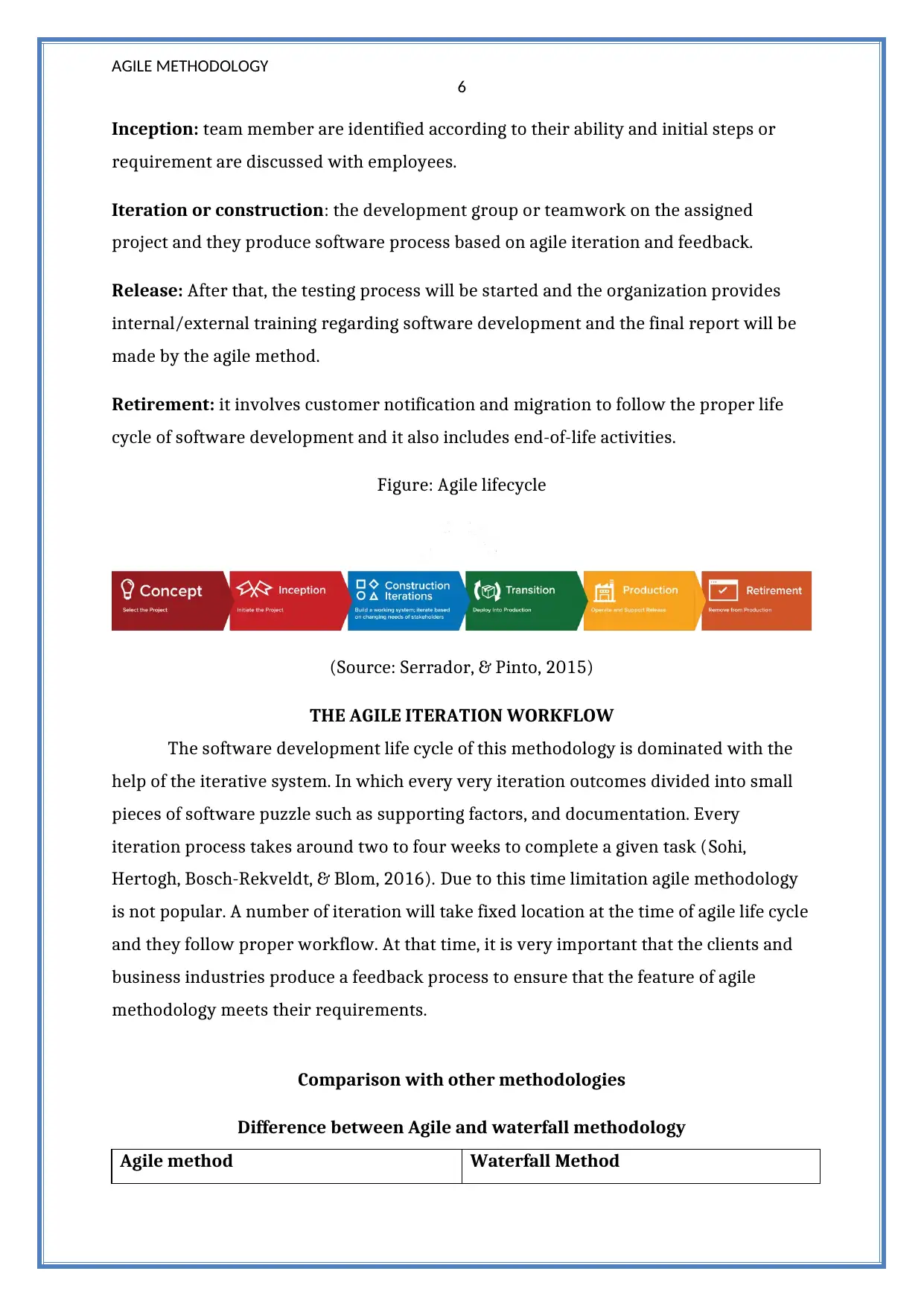
AGILE METHODOLOGY
6
Inception: team member are identified according to their ability and initial steps or
requirement are discussed with employees.
Iteration or construction: the development group or teamwork on the assigned
project and they produce software process based on agile iteration and feedback.
Release: After that, the testing process will be started and the organization provides
internal/external training regarding software development and the final report will be
made by the agile method.
Retirement: it involves customer notification and migration to follow the proper life
cycle of software development and it also includes end-of-life activities.
Figure: Agile lifecycle
(Source: Serrador, & Pinto, 2015)
THE AGILE ITERATION WORKFLOW
The software development life cycle of this methodology is dominated with the
help of the iterative system. In which every very iteration outcomes divided into small
pieces of software puzzle such as supporting factors, and documentation. Every
iteration process takes around two to four weeks to complete a given task (Sohi,
Hertogh, Bosch-Rekveldt, & Blom, 2016). Due to this time limitation agile methodology
is not popular. A number of iteration will take fixed location at the time of agile life cycle
and they follow proper workflow. At that time, it is very important that the clients and
business industries produce a feedback process to ensure that the feature of agile
methodology meets their requirements.
Comparison with other methodologies
Difference between Agile and waterfall methodology
Agile method Waterfall Method
6
Inception: team member are identified according to their ability and initial steps or
requirement are discussed with employees.
Iteration or construction: the development group or teamwork on the assigned
project and they produce software process based on agile iteration and feedback.
Release: After that, the testing process will be started and the organization provides
internal/external training regarding software development and the final report will be
made by the agile method.
Retirement: it involves customer notification and migration to follow the proper life
cycle of software development and it also includes end-of-life activities.
Figure: Agile lifecycle
(Source: Serrador, & Pinto, 2015)
THE AGILE ITERATION WORKFLOW
The software development life cycle of this methodology is dominated with the
help of the iterative system. In which every very iteration outcomes divided into small
pieces of software puzzle such as supporting factors, and documentation. Every
iteration process takes around two to four weeks to complete a given task (Sohi,
Hertogh, Bosch-Rekveldt, & Blom, 2016). Due to this time limitation agile methodology
is not popular. A number of iteration will take fixed location at the time of agile life cycle
and they follow proper workflow. At that time, it is very important that the clients and
business industries produce a feedback process to ensure that the feature of agile
methodology meets their requirements.
Comparison with other methodologies
Difference between Agile and waterfall methodology
Agile method Waterfall Method
Paraphrase This Document
Need a fresh take? Get an instant paraphrase of this document with our AI Paraphraser
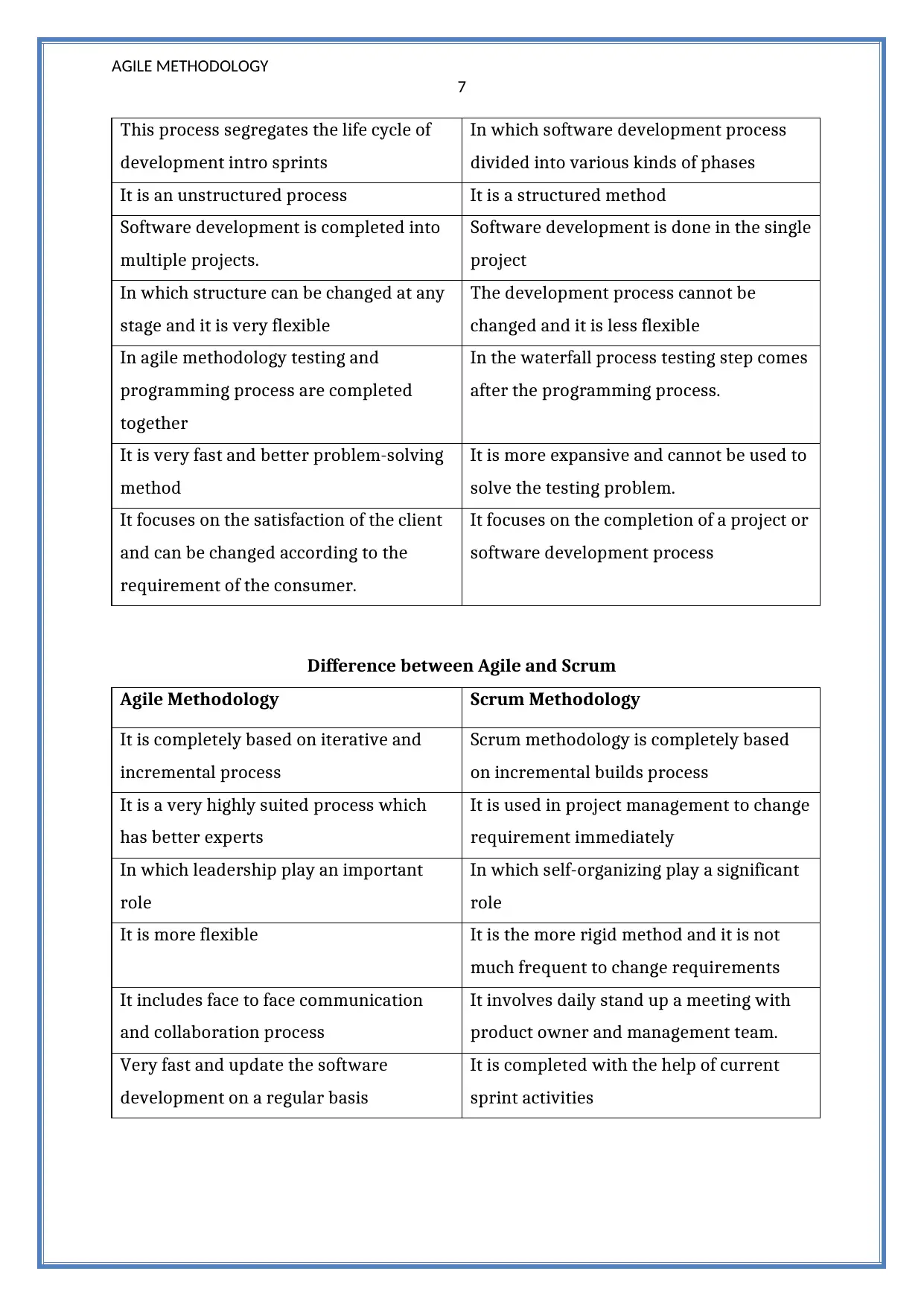
AGILE METHODOLOGY
7
This process segregates the life cycle of
development intro sprints
In which software development process
divided into various kinds of phases
It is an unstructured process It is a structured method
Software development is completed into
multiple projects.
Software development is done in the single
project
In which structure can be changed at any
stage and it is very flexible
The development process cannot be
changed and it is less flexible
In agile methodology testing and
programming process are completed
together
In the waterfall process testing step comes
after the programming process.
It is very fast and better problem-solving
method
It is more expansive and cannot be used to
solve the testing problem.
It focuses on the satisfaction of the client
and can be changed according to the
requirement of the consumer.
It focuses on the completion of a project or
software development process
Difference between Agile and Scrum
Agile Methodology Scrum Methodology
It is completely based on iterative and
incremental process
Scrum methodology is completely based
on incremental builds process
It is a very highly suited process which
has better experts
It is used in project management to change
requirement immediately
In which leadership play an important
role
In which self-organizing play a significant
role
It is more flexible It is the more rigid method and it is not
much frequent to change requirements
It includes face to face communication
and collaboration process
It involves daily stand up a meeting with
product owner and management team.
Very fast and update the software
development on a regular basis
It is completed with the help of current
sprint activities
7
This process segregates the life cycle of
development intro sprints
In which software development process
divided into various kinds of phases
It is an unstructured process It is a structured method
Software development is completed into
multiple projects.
Software development is done in the single
project
In which structure can be changed at any
stage and it is very flexible
The development process cannot be
changed and it is less flexible
In agile methodology testing and
programming process are completed
together
In the waterfall process testing step comes
after the programming process.
It is very fast and better problem-solving
method
It is more expansive and cannot be used to
solve the testing problem.
It focuses on the satisfaction of the client
and can be changed according to the
requirement of the consumer.
It focuses on the completion of a project or
software development process
Difference between Agile and Scrum
Agile Methodology Scrum Methodology
It is completely based on iterative and
incremental process
Scrum methodology is completely based
on incremental builds process
It is a very highly suited process which
has better experts
It is used in project management to change
requirement immediately
In which leadership play an important
role
In which self-organizing play a significant
role
It is more flexible It is the more rigid method and it is not
much frequent to change requirements
It includes face to face communication
and collaboration process
It involves daily stand up a meeting with
product owner and management team.
Very fast and update the software
development on a regular basis
It is completed with the help of current
sprint activities
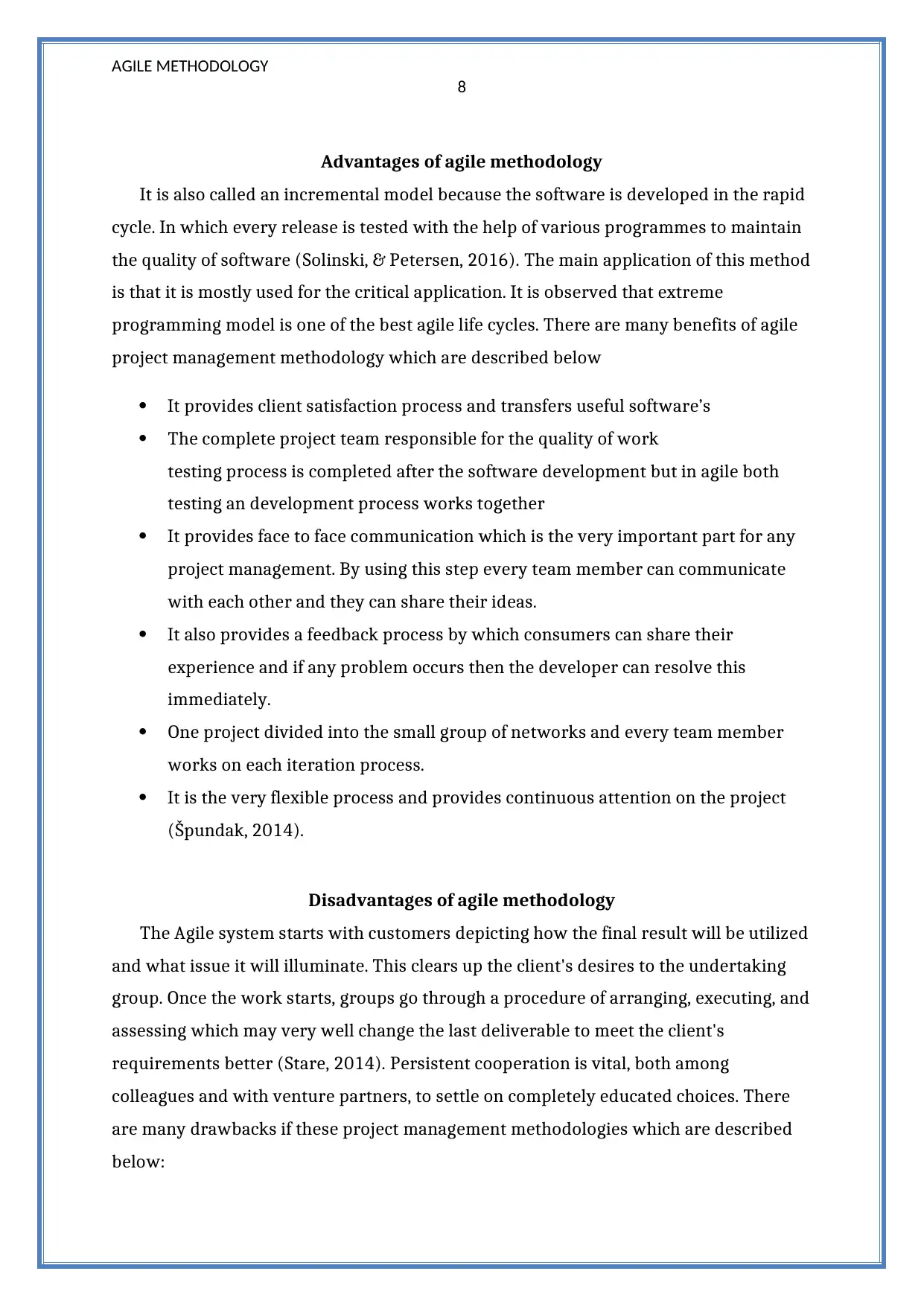
AGILE METHODOLOGY
8
Advantages of agile methodology
It is also called an incremental model because the software is developed in the rapid
cycle. In which every release is tested with the help of various programmes to maintain
the quality of software (Solinski, & Petersen, 2016). The main application of this method
is that it is mostly used for the critical application. It is observed that extreme
programming model is one of the best agile life cycles. There are many benefits of agile
project management methodology which are described below
It provides client satisfaction process and transfers useful software’s
The complete project team responsible for the quality of work
testing process is completed after the software development but in agile both
testing an development process works together
It provides face to face communication which is the very important part for any
project management. By using this step every team member can communicate
with each other and they can share their ideas.
It also provides a feedback process by which consumers can share their
experience and if any problem occurs then the developer can resolve this
immediately.
One project divided into the small group of networks and every team member
works on each iteration process.
It is the very flexible process and provides continuous attention on the project
(Špundak, 2014).
Disadvantages of agile methodology
The Agile system starts with customers depicting how the final result will be utilized
and what issue it will illuminate. This clears up the client's desires to the undertaking
group. Once the work starts, groups go through a procedure of arranging, executing, and
assessing which may very well change the last deliverable to meet the client's
requirements better (Stare, 2014). Persistent cooperation is vital, both among
colleagues and with venture partners, to settle on completely educated choices. There
are many drawbacks if these project management methodologies which are described
below:
8
Advantages of agile methodology
It is also called an incremental model because the software is developed in the rapid
cycle. In which every release is tested with the help of various programmes to maintain
the quality of software (Solinski, & Petersen, 2016). The main application of this method
is that it is mostly used for the critical application. It is observed that extreme
programming model is one of the best agile life cycles. There are many benefits of agile
project management methodology which are described below
It provides client satisfaction process and transfers useful software’s
The complete project team responsible for the quality of work
testing process is completed after the software development but in agile both
testing an development process works together
It provides face to face communication which is the very important part for any
project management. By using this step every team member can communicate
with each other and they can share their ideas.
It also provides a feedback process by which consumers can share their
experience and if any problem occurs then the developer can resolve this
immediately.
One project divided into the small group of networks and every team member
works on each iteration process.
It is the very flexible process and provides continuous attention on the project
(Špundak, 2014).
Disadvantages of agile methodology
The Agile system starts with customers depicting how the final result will be utilized
and what issue it will illuminate. This clears up the client's desires to the undertaking
group. Once the work starts, groups go through a procedure of arranging, executing, and
assessing which may very well change the last deliverable to meet the client's
requirements better (Stare, 2014). Persistent cooperation is vital, both among
colleagues and with venture partners, to settle on completely educated choices. There
are many drawbacks if these project management methodologies which are described
below:
⊘ This is a preview!⊘
Do you want full access?
Subscribe today to unlock all pages.

Trusted by 1+ million students worldwide
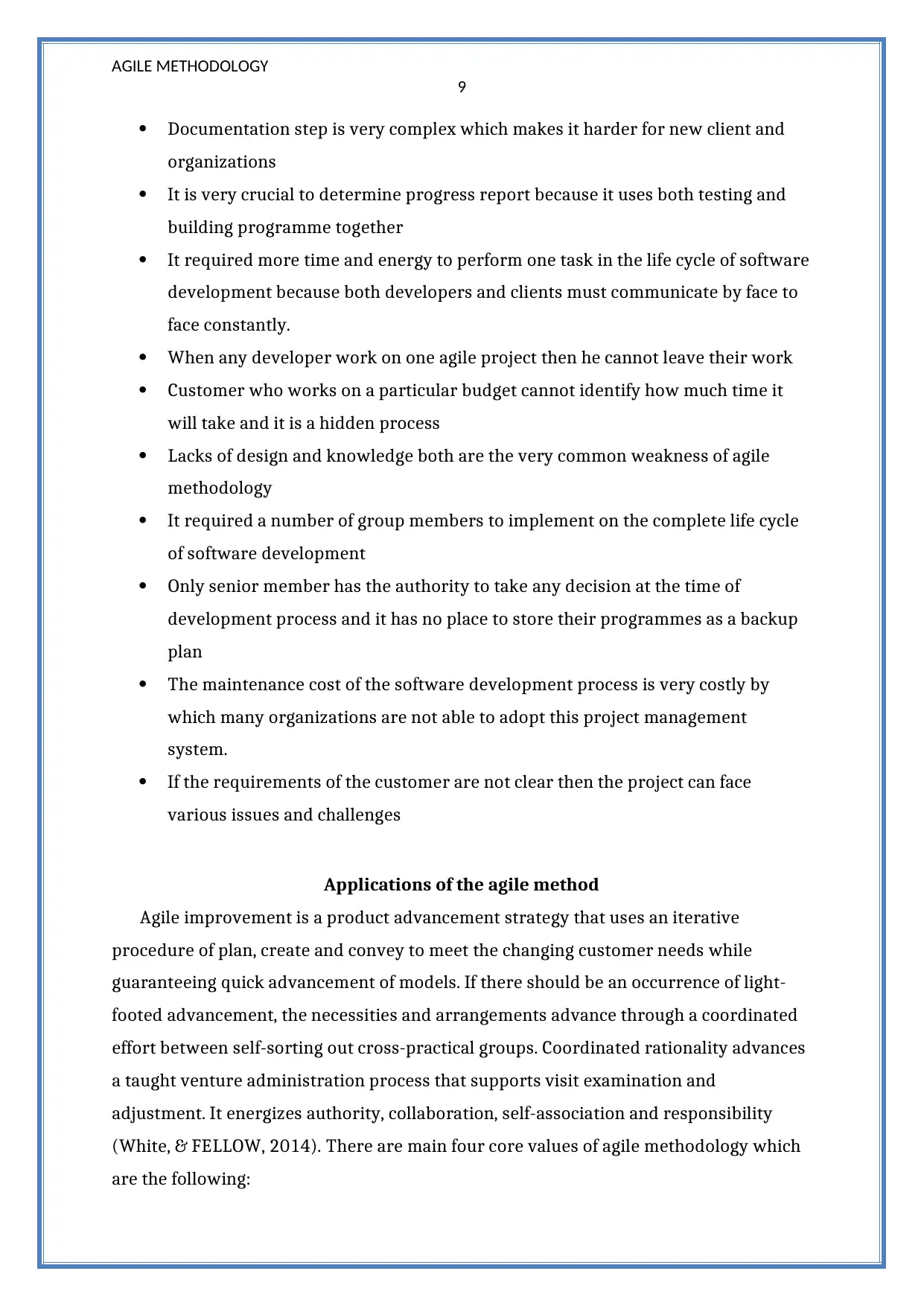
AGILE METHODOLOGY
9
Documentation step is very complex which makes it harder for new client and
organizations
It is very crucial to determine progress report because it uses both testing and
building programme together
It required more time and energy to perform one task in the life cycle of software
development because both developers and clients must communicate by face to
face constantly.
When any developer work on one agile project then he cannot leave their work
Customer who works on a particular budget cannot identify how much time it
will take and it is a hidden process
Lacks of design and knowledge both are the very common weakness of agile
methodology
It required a number of group members to implement on the complete life cycle
of software development
Only senior member has the authority to take any decision at the time of
development process and it has no place to store their programmes as a backup
plan
The maintenance cost of the software development process is very costly by
which many organizations are not able to adopt this project management
system.
If the requirements of the customer are not clear then the project can face
various issues and challenges
Applications of the agile method
Agile improvement is a product advancement strategy that uses an iterative
procedure of plan, create and convey to meet the changing customer needs while
guaranteeing quick advancement of models. If there should be an occurrence of light-
footed advancement, the necessities and arrangements advance through a coordinated
effort between self-sorting out cross-practical groups. Coordinated rationality advances
a taught venture administration process that supports visit examination and
adjustment. It energizes authority, collaboration, self-association and responsibility
(White, & FELLOW, 2014). There are main four core values of agile methodology which
are the following:
9
Documentation step is very complex which makes it harder for new client and
organizations
It is very crucial to determine progress report because it uses both testing and
building programme together
It required more time and energy to perform one task in the life cycle of software
development because both developers and clients must communicate by face to
face constantly.
When any developer work on one agile project then he cannot leave their work
Customer who works on a particular budget cannot identify how much time it
will take and it is a hidden process
Lacks of design and knowledge both are the very common weakness of agile
methodology
It required a number of group members to implement on the complete life cycle
of software development
Only senior member has the authority to take any decision at the time of
development process and it has no place to store their programmes as a backup
plan
The maintenance cost of the software development process is very costly by
which many organizations are not able to adopt this project management
system.
If the requirements of the customer are not clear then the project can face
various issues and challenges
Applications of the agile method
Agile improvement is a product advancement strategy that uses an iterative
procedure of plan, create and convey to meet the changing customer needs while
guaranteeing quick advancement of models. If there should be an occurrence of light-
footed advancement, the necessities and arrangements advance through a coordinated
effort between self-sorting out cross-practical groups. Coordinated rationality advances
a taught venture administration process that supports visit examination and
adjustment. It energizes authority, collaboration, self-association and responsibility
(White, & FELLOW, 2014). There are main four core values of agile methodology which
are the following:
Paraphrase This Document
Need a fresh take? Get an instant paraphrase of this document with our AI Paraphraser
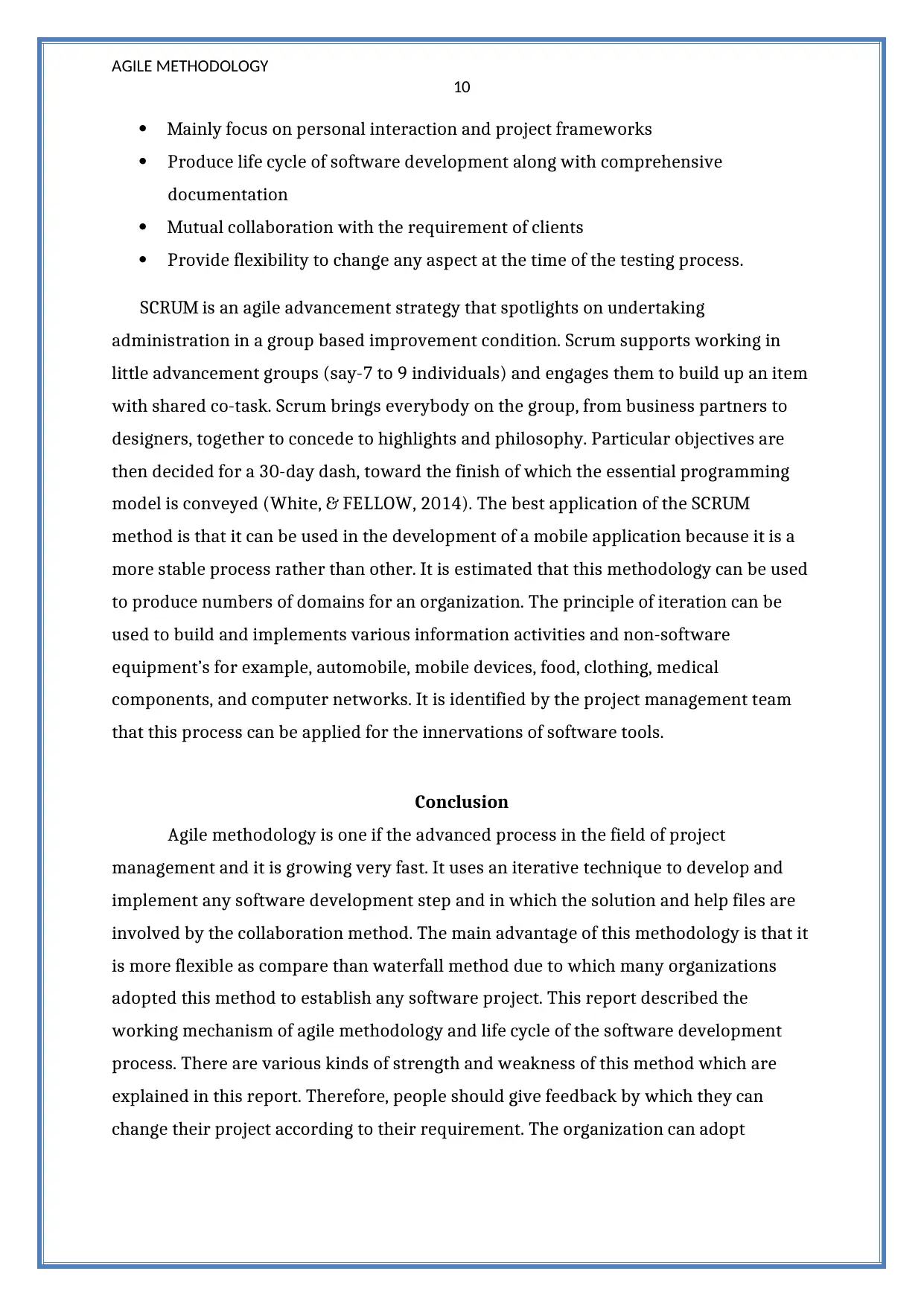
AGILE METHODOLOGY
10
Mainly focus on personal interaction and project frameworks
Produce life cycle of software development along with comprehensive
documentation
Mutual collaboration with the requirement of clients
Provide flexibility to change any aspect at the time of the testing process.
SCRUM is an agile advancement strategy that spotlights on undertaking
administration in a group based improvement condition. Scrum supports working in
little advancement groups (say-7 to 9 individuals) and engages them to build up an item
with shared co-task. Scrum brings everybody on the group, from business partners to
designers, together to concede to highlights and philosophy. Particular objectives are
then decided for a 30-day dash, toward the finish of which the essential programming
model is conveyed (White, & FELLOW, 2014). The best application of the SCRUM
method is that it can be used in the development of a mobile application because it is a
more stable process rather than other. It is estimated that this methodology can be used
to produce numbers of domains for an organization. The principle of iteration can be
used to build and implements various information activities and non-software
equipment’s for example, automobile, mobile devices, food, clothing, medical
components, and computer networks. It is identified by the project management team
that this process can be applied for the innervations of software tools.
Conclusion
Agile methodology is one if the advanced process in the field of project
management and it is growing very fast. It uses an iterative technique to develop and
implement any software development step and in which the solution and help files are
involved by the collaboration method. The main advantage of this methodology is that it
is more flexible as compare than waterfall method due to which many organizations
adopted this method to establish any software project. This report described the
working mechanism of agile methodology and life cycle of the software development
process. There are various kinds of strength and weakness of this method which are
explained in this report. Therefore, people should give feedback by which they can
change their project according to their requirement. The organization can adopt
10
Mainly focus on personal interaction and project frameworks
Produce life cycle of software development along with comprehensive
documentation
Mutual collaboration with the requirement of clients
Provide flexibility to change any aspect at the time of the testing process.
SCRUM is an agile advancement strategy that spotlights on undertaking
administration in a group based improvement condition. Scrum supports working in
little advancement groups (say-7 to 9 individuals) and engages them to build up an item
with shared co-task. Scrum brings everybody on the group, from business partners to
designers, together to concede to highlights and philosophy. Particular objectives are
then decided for a 30-day dash, toward the finish of which the essential programming
model is conveyed (White, & FELLOW, 2014). The best application of the SCRUM
method is that it can be used in the development of a mobile application because it is a
more stable process rather than other. It is estimated that this methodology can be used
to produce numbers of domains for an organization. The principle of iteration can be
used to build and implements various information activities and non-software
equipment’s for example, automobile, mobile devices, food, clothing, medical
components, and computer networks. It is identified by the project management team
that this process can be applied for the innervations of software tools.
Conclusion
Agile methodology is one if the advanced process in the field of project
management and it is growing very fast. It uses an iterative technique to develop and
implement any software development step and in which the solution and help files are
involved by the collaboration method. The main advantage of this methodology is that it
is more flexible as compare than waterfall method due to which many organizations
adopted this method to establish any software project. This report described the
working mechanism of agile methodology and life cycle of the software development
process. There are various kinds of strength and weakness of this method which are
explained in this report. Therefore, people should give feedback by which they can
change their project according to their requirement. The organization can adopt
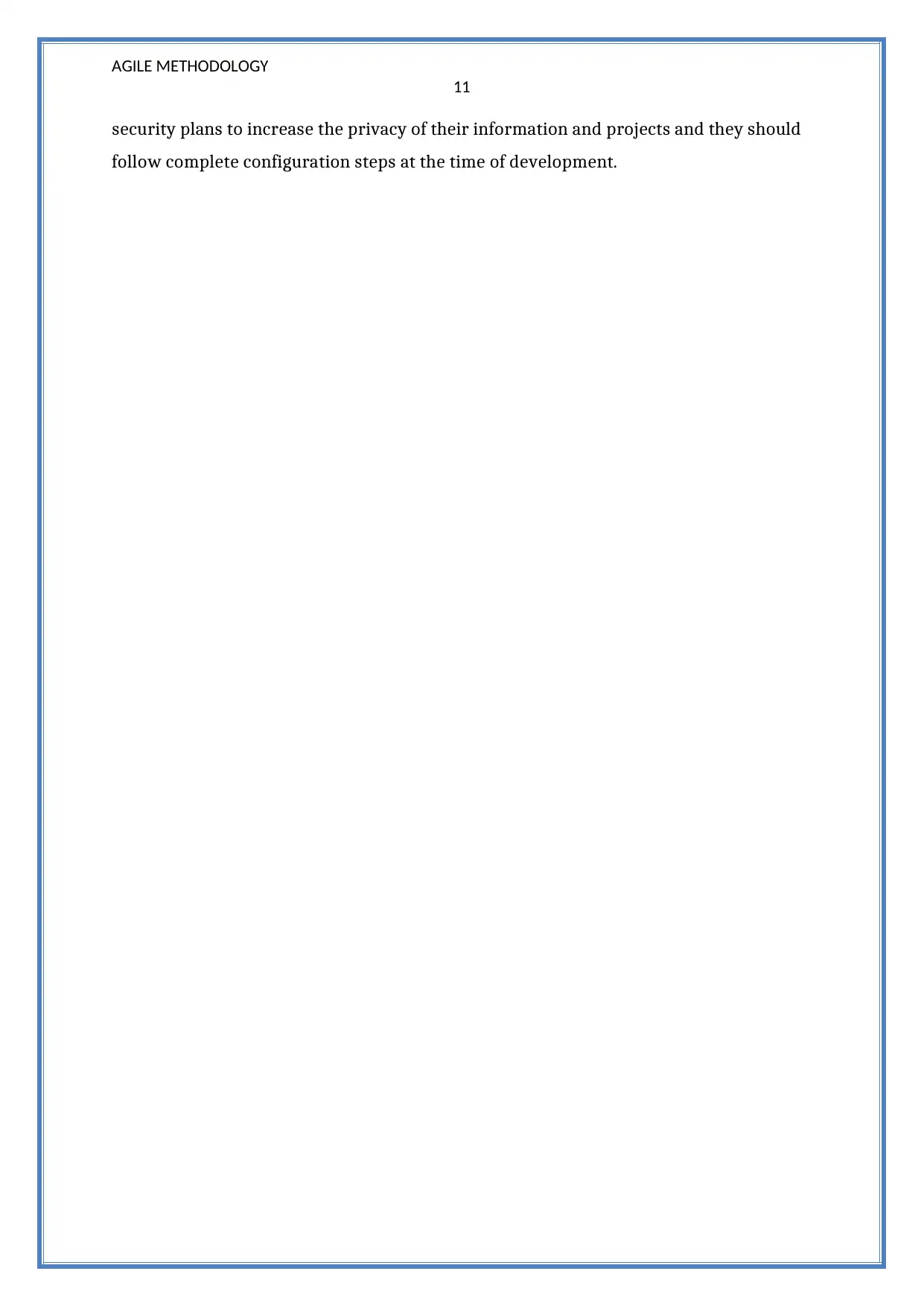
AGILE METHODOLOGY
11
security plans to increase the privacy of their information and projects and they should
follow complete configuration steps at the time of development.
11
security plans to increase the privacy of their information and projects and they should
follow complete configuration steps at the time of development.
⊘ This is a preview!⊘
Do you want full access?
Subscribe today to unlock all pages.

Trusted by 1+ million students worldwide
1 out of 15
Related Documents
Your All-in-One AI-Powered Toolkit for Academic Success.
+13062052269
info@desklib.com
Available 24*7 on WhatsApp / Email
![[object Object]](/_next/static/media/star-bottom.7253800d.svg)
Unlock your academic potential
Copyright © 2020–2025 A2Z Services. All Rights Reserved. Developed and managed by ZUCOL.





